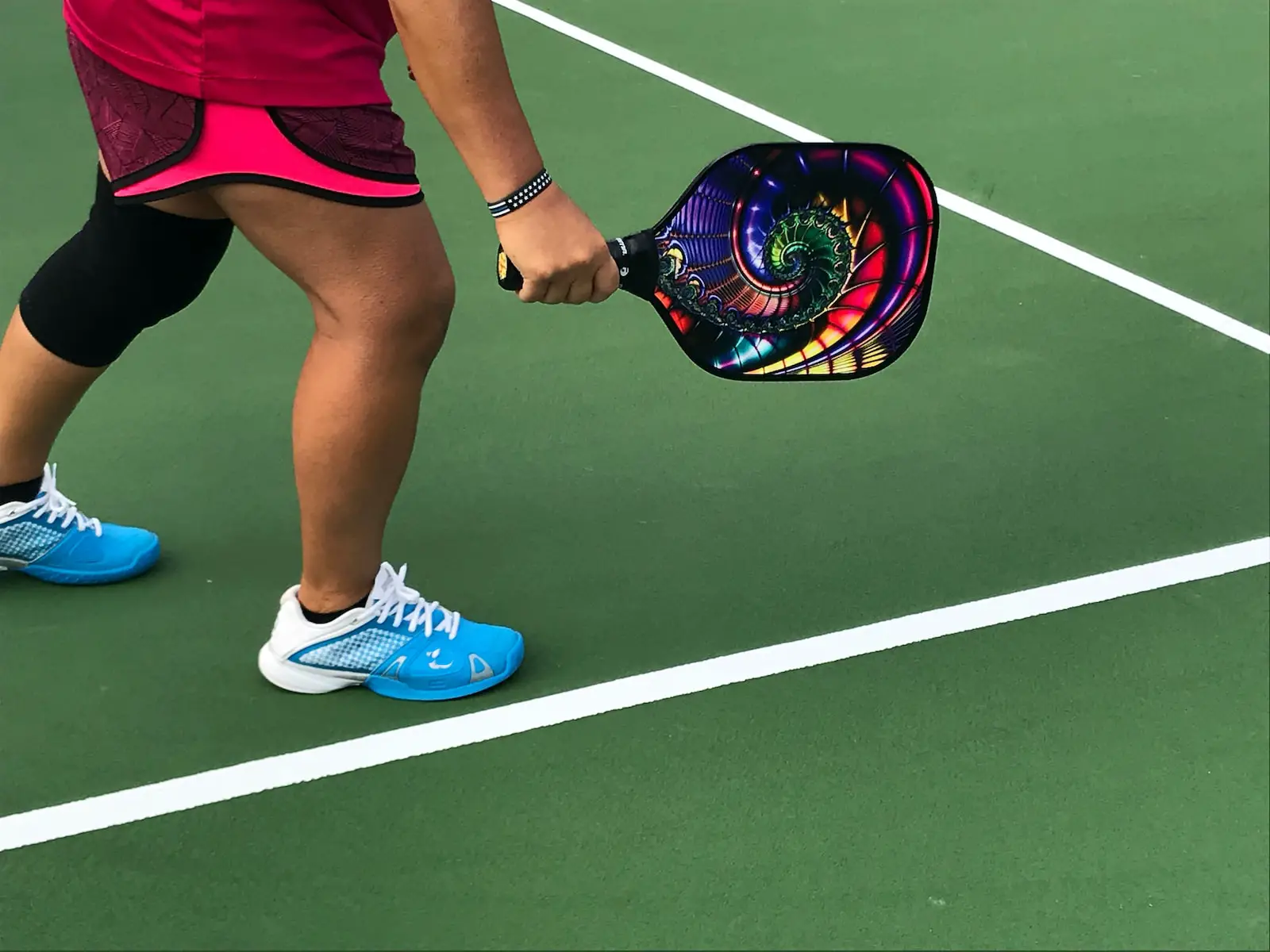If you’re like me, you’ve probably heard the term “the kitchen” thrown around in pickleball circles. But what exactly is it? And why’s it so important in the game? Well, I’m here to break it down for you.
The kitchen, also known as the non-volley zone, is a key area on the pickleball court. It’s a 7-foot zone on either side of the net where volleying (hitting the ball before it bounces) is not allowed. Mastering the rules and strategies related to this zone can significantly boost your pickleball game.
You might be thinking, “Why’s it called the kitchen?” That’s a great question! The term “kitchen” is believed to have originated from the phrase “stay out of the kitchen,” a common saying in pickleball that means to avoid volleying in the non-volley zone. Stick around as we delve deeper into the significance of the kitchen in pickleball.
What is the Kitchen in Pickleball?
Before we delve deeper, let’s take a moment to clarify what exactly is the kitchen in pickleball. Known officially as the non-volley zone, the kitchen is a critical area on the court. It spans about 7 feet on either side of the net and is marked by distinct lines. This area’s intriguing nickname sounds rather domestic, but it’s a central element in a thrilling, competitive sport.
Exception to the general rule occurs when a ball bounces in the kitchen. Only then can a player step into this zone to make a shot. But remember, once in the kitchen, no volleying is allowed. Step in to hit a volley and you’ll find yourself losing a point.
The origin of the term kitchen in pickleball is somewhat murky but it’s believed to have derived from an old pickleball saying: “stay out of the kitchen”. It was a playful way of reminding players not to volley in the non-volley zone. Today, it has evolved into a keystone concept in strategic play.
Perhaps you’re wondering about the significance of the game’s kitchen. It’s much more than just a peculiarly named zone on the court. Grasping the rules and strategies around the kitchen can be pretty much likened to mastering your secret recipe in the actual kitchen. It’s the secret sauce to stepping up your pickleball game.
In the next section, we’ll deep-dive into strategies on how to effectively play — and stay out of — the kitchen to your advantage. Stepping into the kitchen isn’t always a faux pas in pickleball — it’s knowing when and how to do so that makes all the difference.
The Rules of the Kitchen in Pickleball

The intricate rules tied to the kitchen in pickleball can seem daunting at first glance. Yet, Once you grasp them, you’ll better your pickleball strategy and improve your game. This segment looks into those fundamental rules that govern the kitchen.
One primary rule is that the kitchen is a non-volley zone. This implies that volleying the ball directly from the air within the kitchen is a foul. However, there is a twist: if the ball bounces in the kitchen, you’re allowed to enter the zone and make your strike. Yet, it’s vital to exit swiftly, or you’ll lose a point for camping out.
| Rule | Description |
|---|---|
| Rule#1 | The kitchen is a non-volley zone |
| Rule#2 | Only after the ball bounces in the kitchen, you can enter the zone |
| Rule#3 | Exit the kitchen quickly after your strike, or you risk losing a point |
Furthermore, a rule that baffles many beginners regards stepping into the kitchen during or after a volley. If you make a volley while your momentum carries you into the kitchen, it’s considered a fault even if you make contact outside of the kitchen. This is famously known as the “Momentum Rule.”
In essence, these rules reinforce the kitchen’s purpose to keep the game fair and exciting. They prevent players from ‘camping out’ at the net and monopolizing the game. This forces players to use precision, strategy and dexterity as opposed to brute force. Practicing these rules is not just about abiding by the regulations; it’s about mastering the art of pickleball. As we unfold the strategies to brake these rules into your gameplay, you’ll have a more in-depth understanding of the significance of these rules, which is a powerful insight for a pickleball player.
Strategies for Playing in the Kitchen

The term ‘kitchen’ may sound odd to novice pickleball players, but mastering this zone is key to leveling up your game. Today, I’m sharing insider tips and tricks on how to utilize the kitchen to your advantage.
One effective strategy is dinking. This technique involves primarily hitting the ball just enough to get it over the net and into your opponent’s kitchen, forcing them to be caught in a non-volley situation. Aim for slow, controlled shots to ensure accuracy. Timing and finesse are critical for successful dinking.
Another strategy is third shot drop. When it’s my turn to serve or return, my first goal is getting my team to the net. Successful third shot drops allow me to move forward, join my partner at the net, and put pressure on my opponents by keeping them back and limiting their shot options.
Use the fourths shot drive technique when possible. When my opponents successfully execute a third shot drop, countering with a fourth shot drive can catch them off guard. The fourths shot drive needs to be quick and low, denying the opponents a chance to dink and apply pressure.
When it comes to kitchen rules, practice makes perfect. So, pick up that paddle, step onto the court, and get ready to cook up a storm in the kitchen. Remember:
- Dinking is all about control and precision
- A good third shot drop can get you to the net fast
- The fourth shot drive should counter a perfect third shot drop
Each technique brings its own advantages to the table. Varying your kitchen strategies keeps opponents guessing and increases your chances of success. The key takeaway is understanding which strategy to apply and when.
Studying these kitchen strategies is important, but implementing them in a real game scenario requires practice and patience. Dive into these strategies in your practice sessions and watch how they revolutionize your pickleball game.
Common Mistakes to Avoid in the Kitchen

As a seasoned player, there’s one thing I’ve noted over the years: It’s quite easy to fall into common pitfalls, especially when it comes to navigating the kitchen.
One of the most frequent mistakes has to do with violating the kitchen rules. Understanding how and when you can step into the kitchen can be challenging for beginners. However, you’ll definitely want to steer clear of faults such as stepping into the kitchen during or after a volley. Be aware of your feet, make sure they’re firmly planted outside the kitchen before you take that swing.
Next up is a mistake infamous in the pickleball circuits: neglecting the art of dinking. Dinking, a soft shot designed to land in the kitchen, is integral in pickleball strategy. It aims to limit your opponent’s ability to deliver a hard return. Yet, many players, caught in the thrill of powerful slams, forget this important tool. Remember, control and precision often trump power in pickleball.
Another common blunder lies with the third shot drop. The objective of this shot is to land the ball in the kitchen, forcing your opponents near the net and limiting their attack options. Easy to plan, hard to master. I’ve seen countless players attempting to hit a winner with this shot, often resulting in a fault, instead of focusing on placing it correctly to build a strategic advantage.
Lastly, let’s talk about the culprit of so many lost points: incorrect use of the fourth shot drive. Remember, unlike the third shot drop, the fourth shot drive is a powerful shot aimed at pressuring the opposing team. When used correctly, it can keep your opponents on their toes.
But beware. Underestimating its power can lead to overshooting, where the ball goes out of the court, or worse, easy-to-return lob for your adversaries. One’s timing and shot selection are crucial aspects of a successful fourth shot drive.
The Significance of the Kitchen in Pickleball
The kitchen in Pickleball holds a key role in shaping the game’s unique dynamics. Its rules and restrictions add an extra layer of complexity that sets the game apart from other racquet sports. The crucial question remains: why is the kitchen so important in pickleball?
One of the answers lies in the denying power it holds. By acting as a no-volley zone, it paves way for a volley-free path from the baseline to the net. This provides balance – it keeps the players from getting too close to the net and monopolizing gameplay.
Moreover, mastering the kitchen is a game changer. Understanding its rules and intricacies, such as the Momentum Rule, can truly enhance one’s game. A simple step over the line could drastically change the game’s outcome. Think about it. Avoiding a fault through understanding kitchen rules is just as significant as hitting a spectacular winner.
To top it off, the tactics involved around the kitchen provide a real test of player’s abilities. Dinking, third shot drop, and fourth shot drive – none of these can truly shine without the constraints posed by the kitchen. They are the tools in a player’s arsenal that create exciting plays, force errors, and dictate the pace of the game.
One can’t overlook the significance of these strategies. To be effective in pickleball, you need to master these precision-based techniques. Practicing them, you’ll learn timing, refine your control, and become adept at outmaneuvering your opponents.
Mistakes, of course, are part of the journey. Maybe you’ve violated the kitchen rules, mishandled the third shot drop, or even misused the fourth shot drive. It’s important to acknowledge these errors. Doing so gives you the opportunity to make necessary adjustments – to revolutionize your game.
As you can see, the kitchen in Pickleball isn’t just a funny name or a part of the court—it’s a fundamental element that shapes every aspect of the game.
Conclusion
So there you have it. The kitchen isn’t just a part of the pickleball court; it’s the heart of the game. Its unique rules and the tactics it encourages are what make pickleball a challenge worth tackling. Mastering the kitchen’s nuances, from the Momentum Rule to precision-based techniques like dinking, third shot drop, and fourth shot drive, can take your game to a whole new level. But remember, it’s not just about winning. It’s about learning and growing. Mistakes made in the kitchen aren’t failures; they’re stepping stones to becoming a better player. So get out there, embrace the kitchen, and let it revolutionize your game. After all, the kitchen is where some of the magic happens in pickleball.














0 Comments